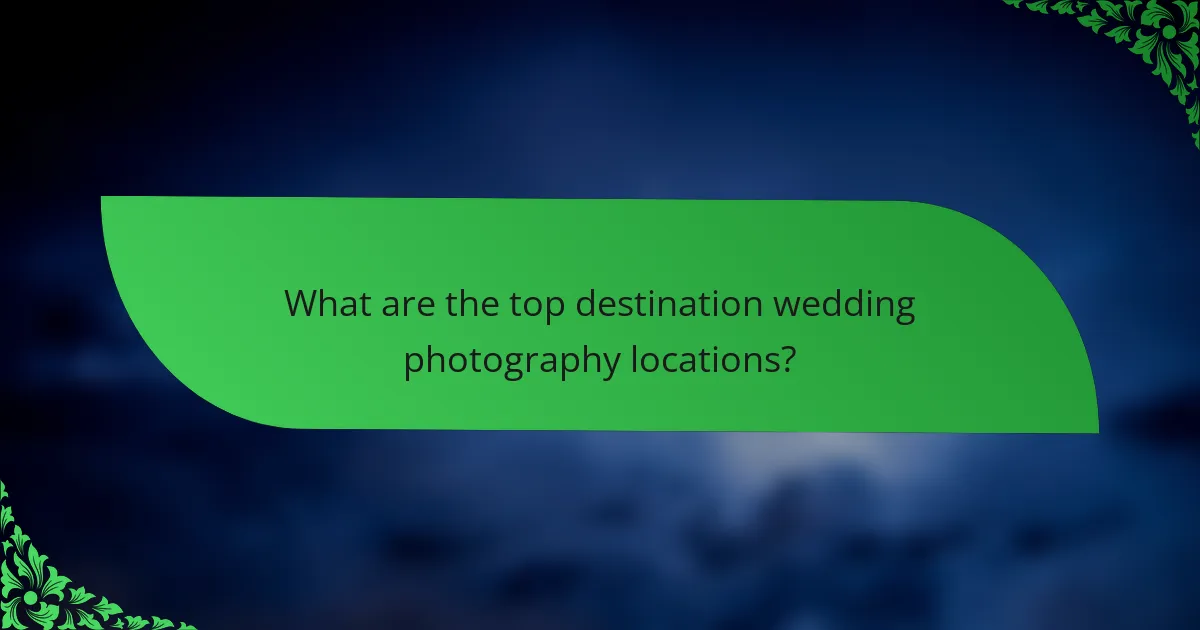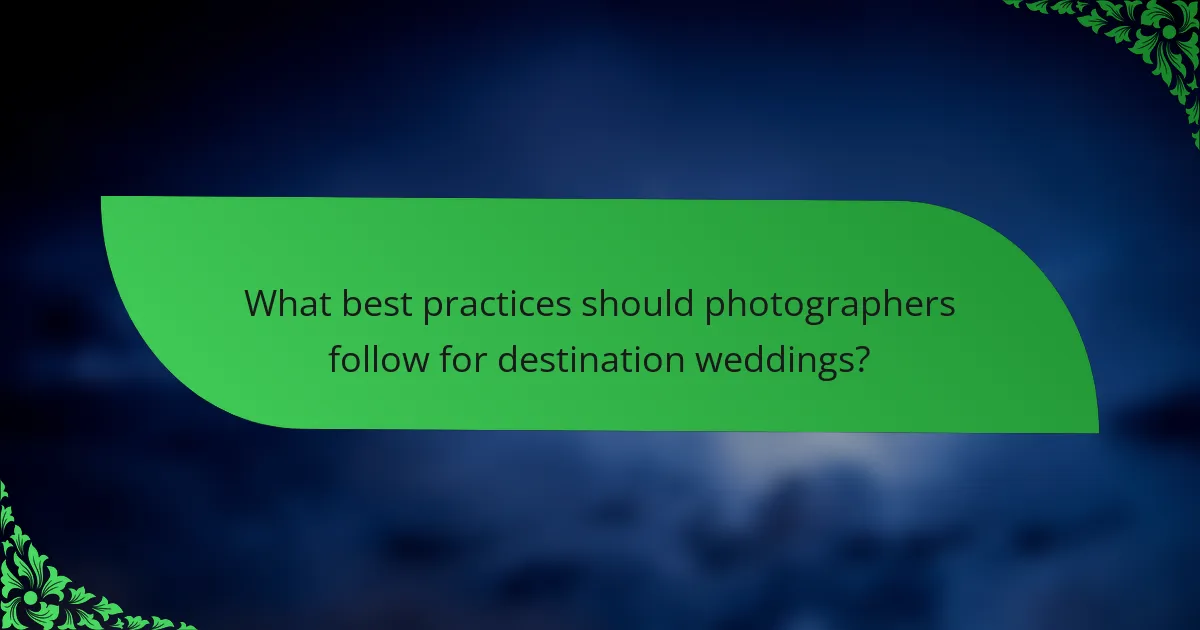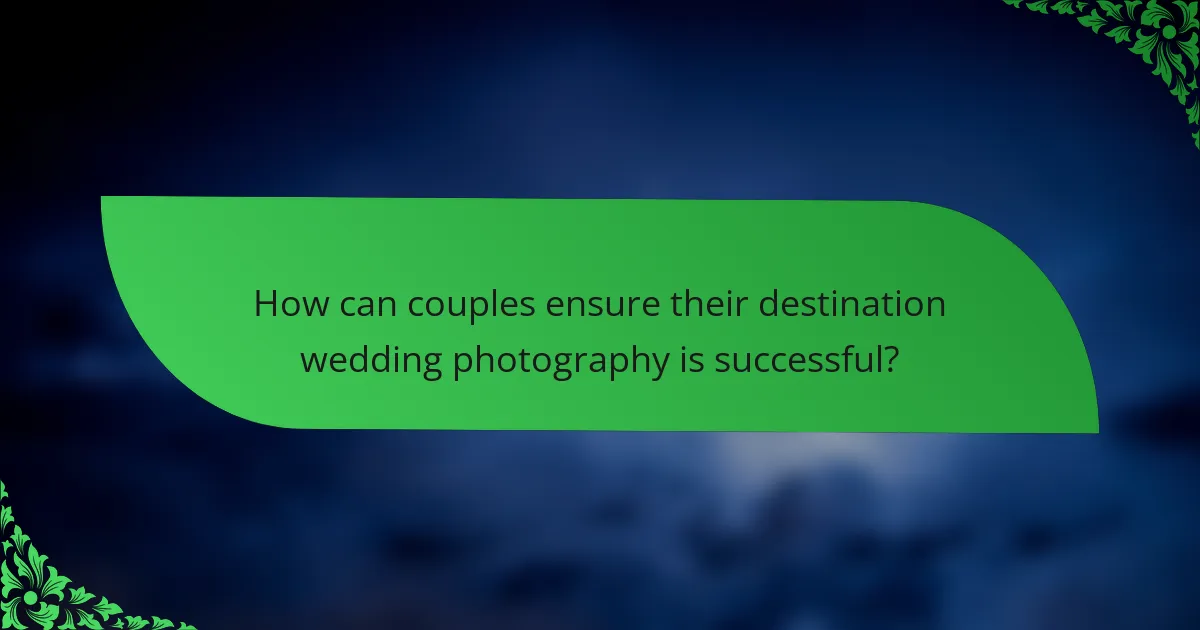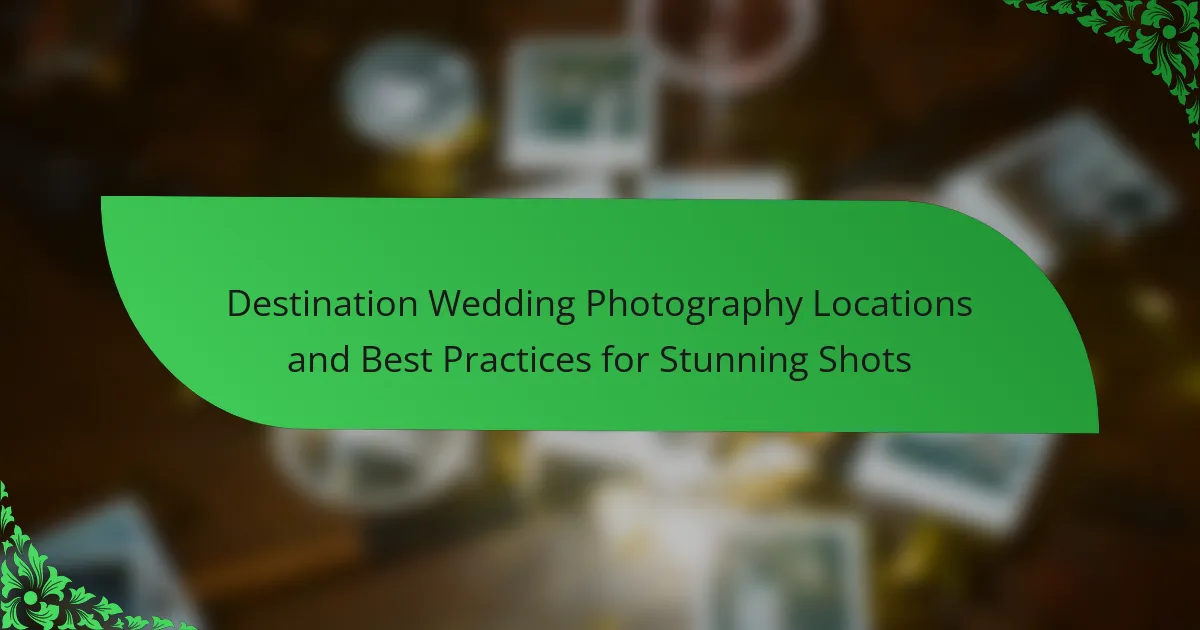Destination wedding photography focuses on capturing memorable moments in scenic locations. Popular destinations for such photography include Santorini, Bali, Tuscany, Maui, the Amalfi Coast, and Paris, each offering unique landscapes and atmospheric backdrops. Effective planning is essential for successful photography, which involves researching locations, communicating with couples, creating shot lists, and scouting venues. Photographers should also be prepared for varying weather and ensure all equipment is ready. Couples can enhance their photography experience by selecting an experienced photographer, scouting venues, and maintaining a relaxed demeanor during the shoot.

What are the top destination wedding photography locations?
The top destination wedding photography locations include Santorini, Bali, and Tuscany. Santorini is renowned for its stunning sunsets and whitewashed buildings. Bali offers lush landscapes and beautiful beaches. Tuscany features picturesque vineyards and historic architecture. Other notable locations are Maui, Amalfi Coast, and Paris. Maui is famous for its tropical scenery and diverse backdrops. The Amalfi Coast is celebrated for its dramatic cliffs and charming villages. Paris provides iconic landmarks and romantic settings. These locations consistently rank high for their scenic beauty and unique atmospheres.
How do location choices impact wedding photography?
Location choices significantly impact wedding photography by influencing lighting, backdrop, and accessibility. Different locations provide varying natural light conditions that can enhance or detract from the quality of photos. For instance, outdoor venues during golden hour yield softer, more flattering light. The backdrop of a location adds character and context to images, with scenic landscapes or historical architecture creating visually appealing compositions. Accessibility also affects the logistics of photography, including travel time and the ease of moving equipment. A well-chosen location can facilitate creative angles and unique shots, enhancing the overall aesthetic of wedding photography.
What factors should be considered when selecting a location?
When selecting a location for destination wedding photography, consider accessibility, lighting, and scenery. Accessibility ensures guests and vendors can reach the site easily. Lighting affects the quality of photos; natural light is often preferred. Scenery contributes to the aesthetic appeal of images. Weather conditions are also crucial, as they can impact the shoot. Local regulations may restrict certain photography activities. Availability of amenities, such as restrooms and parking, enhances guest experience. Lastly, the venue’s capacity should accommodate the wedding party comfortably.
How do different locations influence the mood of wedding photos?
Different locations significantly influence the mood of wedding photos. Each setting offers unique lighting, colors, and textures. For example, a beach location provides natural light and soft waves, creating a romantic atmosphere. In contrast, an urban setting features vibrant colors and dynamic architecture, which can evoke excitement. Rural landscapes often deliver serene backdrops, enhancing feelings of tranquility. Historical sites can add an element of elegance and timelessness. Additionally, seasonal variations in locations impact the overall mood. Spring blooms can convey freshness, while autumn leaves may evoke warmth. Thus, the choice of location is crucial for capturing the desired emotional tone in wedding photography.
What are some popular scenic destinations for wedding photography?
Popular scenic destinations for wedding photography include locations like Santorini, Greece. This island is known for its stunning sunsets and whitewashed buildings. Another popular spot is Banff National Park in Canada. It offers breathtaking mountain landscapes and turquoise lakes. The Amalfi Coast in Italy is also favored for its dramatic cliffs and charming villages. Bali, Indonesia is renowned for its lush greenery and picturesque beaches. Lastly, the Lavender Fields in Provence, France, provide a vibrant backdrop with their colorful blooms. Each of these locations enhances wedding photography with their unique beauty and romantic settings.
What makes a location ideal for stunning wedding shots?
An ideal location for stunning wedding shots features natural beauty, unique backdrops, and good lighting. Natural beauty includes scenic landscapes, gardens, or beaches that enhance the visual appeal. Unique backdrops, such as historic buildings or artistic structures, add character to the photographs. Good lighting, particularly during golden hour, creates soft and flattering images. Accessibility is also important, ensuring guests can reach the location easily. Moreover, the location should reflect the couple’s personality and style, making the photos more meaningful. These elements collectively contribute to capturing memorable and breathtaking wedding imagery.
How do cultural elements enhance wedding photography in various locations?
Cultural elements enhance wedding photography by adding unique visual and emotional layers. Each location has distinct traditions, attire, and rituals that influence the aesthetic of the photographs. For instance, Indian weddings feature vibrant colors and intricate henna designs, which create visually striking images. In contrast, a traditional Japanese wedding showcases elegant kimonos and serene gardens, offering a different visual appeal.
Incorporating local landmarks or cultural symbols in the backdrop enriches the storytelling aspect of the photos. This helps capture the essence of the couple’s heritage and the significance of their chosen location. Moreover, cultural practices, such as specific ceremonies or dances, provide dynamic moments that photographers can capture. These unique elements contribute to a personalized and memorable wedding album.
Research indicates that culturally themed photography can increase emotional engagement for viewers. A study by the Photography Research Institute found that culturally rich images resonate more with audiences, enhancing the storytelling and emotional impact of wedding photography.

What best practices should photographers follow for destination weddings?
Photographers should prioritize thorough planning for destination weddings. Research the location in advance to understand lighting conditions and scenic spots. Communicate with the couple to align on their vision and preferences. Create a shot list based on the couple’s must-have moments. Scout the venue prior to the wedding day to identify optimal angles and backdrops. Prepare for varying weather conditions by having backup plans. Utilize local vendors for assistance and recommendations. Ensure all equipment is ready and functioning, including backups for critical gear. These practices enhance the quality of the photography and ensure a smooth experience for everyone involved.
How can photographers prepare for destination wedding shoots?
Photographers can prepare for destination wedding shoots by conducting thorough research on the location. Understanding the venue’s layout is crucial for planning shots. Photographers should also scout the area in advance, if possible, to identify the best spots for photography. Creating a shot list tailored to the couple’s preferences helps ensure no important moments are missed. Packing essential gear, including backups, is vital to avoid equipment failures. Familiarizing oneself with local weather conditions aids in planning for lighting and attire. Establishing a communication plan with the couple and vendors ensures smooth coordination on the wedding day. Finally, reviewing local customs and regulations can prevent any unforeseen issues during the shoot.
What equipment is essential for capturing stunning shots on location?
Essential equipment for capturing stunning shots on location includes a high-quality camera, versatile lenses, and a sturdy tripod. A high-quality camera, such as a DSLR or mirrorless model, allows for superior image quality. Versatile lenses, including wide-angle and telephoto options, provide flexibility for various scenes. A sturdy tripod ensures stability, especially in low-light conditions. Additional equipment like external flash and reflectors can enhance lighting. Memory cards with ample storage are crucial for capturing numerous shots. Lastly, a weatherproof camera bag protects gear from environmental elements. Each piece of equipment contributes to achieving high-quality images in diverse locations.
How can photographers scout locations effectively before the wedding day?
Photographers can scout locations effectively by visiting potential sites ahead of the wedding day. They should assess lighting conditions at different times to determine the best moments for shooting. Taking test shots helps in understanding angles and framing. Photographers should also consider accessibility for the couple and guests. Researching the venue’s layout aids in planning efficient movements on the wedding day. Engaging with the venue staff can provide insights into unique spots. Creating a shot list based on the scouting can streamline the photography process. Finally, familiarity with the location boosts confidence and enhances creativity during the event.
What techniques enhance the quality of destination wedding photos?
Utilizing natural light enhances the quality of destination wedding photos. Photographers should aim to shoot during golden hour, which occurs shortly after sunrise and before sunset. This timing provides soft, flattering light that minimizes harsh shadows. Additionally, incorporating diverse compositions can elevate the visual interest of the photos. Techniques such as framing, leading lines, and varying angles contribute to dynamic shots.
Using a prime lens with a wide aperture allows for beautiful background blur, emphasizing the couple. Capturing candid moments adds authenticity to the images, showcasing genuine emotions. Utilizing local landscapes as backdrops enhances the uniqueness of each photo. Finally, post-processing techniques can refine images, ensuring colors and contrasts are vibrant.
How can lighting be optimized for outdoor wedding photography?
To optimize lighting for outdoor wedding photography, use natural light effectively. Position subjects with the sun behind them to create a halo effect. This technique reduces harsh shadows on faces. Utilize reflectors to bounce light onto subjects, enhancing their features. Schedule shoots during golden hour for soft, warm light. This occurs shortly after sunrise or before sunset. Avoid shooting in direct midday sun, as it creates unflattering shadows. Consider using diffusers to soften harsh light, especially in bright conditions. These techniques improve the overall quality of outdoor wedding photographs.
What composition techniques can create breathtaking wedding images?
Utilizing composition techniques such as the rule of thirds enhances wedding images. This technique involves dividing the frame into a grid of nine equal parts. Placing subjects along these lines or intersections creates balance and interest. Leading lines draw the viewer’s eye toward the main subject. These lines can be created using natural elements like pathways or architectural features. Framing techniques use elements in the environment to border the subject. This adds depth and context to the image. Symmetry can evoke a sense of harmony and elegance. Capturing reflections in water or glass can also create stunning visual effects. These techniques are widely recognized in photography to elevate image quality.

How can couples ensure their destination wedding photography is successful?
Couples can ensure their destination wedding photography is successful by planning ahead and communicating effectively with their photographer. Selecting a photographer experienced in destination weddings is crucial. This ensures they understand the unique challenges and opportunities of various locations. Couples should also scout the venue beforehand to identify the best spots for photos. Lighting conditions can vary significantly at different times of day, so timing is essential. Additionally, couples should create a shot list to capture all desired moments. This helps the photographer stay organized and focused. Finally, maintaining a relaxed demeanor during the shoot can lead to more natural and candid photographs.
What should couples communicate with their photographers before the wedding?
Couples should communicate their vision and expectations with their photographers before the wedding. This includes discussing preferred styles, such as candid or posed shots. Couples should share their wedding timeline to ensure all key moments are captured. Important family dynamics should be communicated to facilitate group photos. Couples should also inform photographers about specific locations or backdrops they desire. Any must-have shots should be listed for clarity. Discussing the photographer’s experience with destination weddings is crucial. Lastly, couples should confirm logistical details, such as travel arrangements and accommodations for the photographer.
How can couples collaborate with photographers to achieve their vision?
Couples can collaborate with photographers by communicating their vision clearly. They should share specific ideas, themes, and styles they prefer. Providing examples of desired shots can help photographers understand their expectations. Couples should discuss any locations that hold significance to them. This can guide the photographer in capturing meaningful moments. Regular check-ins during the planning process can ensure alignment. Couples should also be open to the photographer’s creative input. This collaboration can enhance the overall outcome of the wedding photography.
What role does a shot list play in ensuring memorable moments are captured?
A shot list plays a crucial role in ensuring memorable moments are captured during events. It serves as a detailed plan that outlines specific shots to be taken. This organization helps photographers focus on key moments that matter most to the couple. By having a visual guide, photographers can avoid missing important scenes. A shot list also facilitates efficient time management during the event. It allows for better communication between the couple and the photographer. Research shows that well-prepared photographers are more likely to capture essential moments. This preparation ultimately leads to a more satisfying photography experience for clients.
What common challenges arise in destination wedding photography?
Common challenges in destination wedding photography include logistical issues, unpredictable weather, and cultural differences. Logistical challenges often arise from traveling to remote locations. Photographers may face difficulties with equipment transport and local regulations. Unpredictable weather can disrupt planned shots, especially in tropical or mountainous areas. Photographers must be prepared for sudden changes in light or rain. Cultural differences may impact photography styles and expectations. Understanding local customs is essential for capturing the event appropriately. Additionally, limited time for shoots can pressure photographers to deliver quality work quickly. These factors can complicate the overall photography experience at destination weddings.
How can photographers overcome logistical challenges in remote locations?
Photographers can overcome logistical challenges in remote locations by thorough planning and preparation. They should scout locations in advance, either physically or through online resources. This helps identify potential obstacles and the best spots for shooting. Photographers should also invest in portable equipment that is lightweight and easy to carry. This minimizes the burden during travel.
Creating a detailed timeline is crucial for managing time effectively. It ensures that photographers can capture key moments without rushing. Additionally, photographers should establish reliable communication methods, such as satellite phones, to stay connected in remote areas.
Networking with local contacts can provide valuable insights and assistance. Local guides can help navigate challenging terrains and access hidden gems. Lastly, preparing for various weather conditions ensures that photographers are ready for any situation. This adaptability can lead to unique and stunning shots.
What strategies can be employed to handle unpredictable weather conditions?
Utilizing flexible scheduling is a key strategy to handle unpredictable weather conditions. Photographers can plan for alternative dates or times to capture optimal lighting and scenery. Having backup indoor locations is essential. These spaces should be visually appealing and accessible. Carrying portable lighting equipment helps in low-light situations. Utilizing weather apps provides real-time updates for better planning. Communicating with clients about potential weather impacts ensures they are prepared. Lastly, embracing the weather can lead to unique and creative shots. Rain or overcast skies can create dramatic effects in photography.
What are the best tips for capturing stunning destination wedding shots?
To capture stunning destination wedding shots, prioritize natural lighting. Golden hour, shortly after sunrise or before sunset, provides soft, flattering light. Scout locations beforehand to identify ideal backdrops. Unique landscapes enhance the visual appeal of wedding photos. Use a variety of angles and perspectives to create dynamic compositions. Incorporate candid moments to capture genuine emotions. Communicate with the couple to understand their vision and preferences. Finally, ensure proper equipment is ready, including backups for unexpected situations. These strategies have been proven effective by professional photographers in various destination settings.
How can photographers make the most of unique local elements in their photos?
Photographers can make the most of unique local elements by incorporating them into their compositions. They should research the location to identify distinctive features. This includes architecture, landscapes, and cultural symbols. Utilizing local colors and textures enhances visual storytelling. Photographers can also engage with local communities for authentic interactions. Capturing local traditions or events adds depth to the narrative. Lighting conditions unique to the area can create stunning effects. For example, golden hour in coastal regions offers soft, warm light. By blending these elements, photographers create images that resonate with the local atmosphere.
What post-processing techniques can enhance destination wedding images?
Post-processing techniques that can enhance destination wedding images include color correction, exposure adjustments, and applying filters. Color correction ensures that the colors in the images are accurate and vibrant. This technique can enhance the natural beauty of the location and the couple. Exposure adjustments help to balance the light in the images, making them look more professional. Proper exposure can highlight details in both shadows and highlights. Applying filters can create a specific mood or style, adding a creative touch to the images. For instance, a vintage filter can give a romantic feel, while a bright filter can enhance the tropical vibe of a beach wedding. These techniques, when used effectively, can significantly improve the overall quality of destination wedding photography.
Destination wedding photography revolves around capturing memorable moments in picturesque locations such as Santorini, Bali, and Tuscany, each offering unique attributes that enhance the visual appeal of wedding images. This article explores the impact of location choices on photography, highlighting factors like lighting, accessibility, and scenery that influence the quality and mood of photos. It also provides best practices for photographers, including effective planning, equipment preparation, and techniques to optimize lighting and composition. Additionally, the article discusses the importance of cultural elements and collaboration between couples and photographers to achieve stunning wedding imagery.



